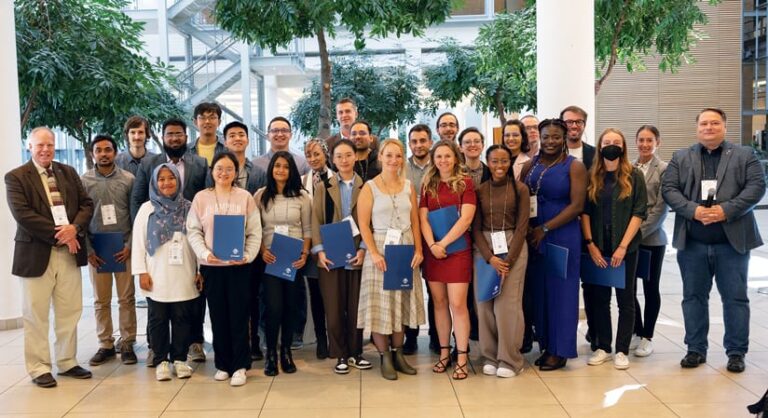Cartographers, geographic information scientists (GIScientists), heads of national mapping agencies, representatives from various institutions and businesses, mapping practitioners, and map enthusiasts converged on Cape Town, South Africa, in August for the 31st International Cartographic Conference (ICC). In all, 845 participants from 78 countries shared a venue for three integrated events: the ICC, a three-day meeting of the United Nations Committee of Experts on Global Geospatial Information Management in Africa (UN-GGIM: Africa), and two workshops sponsored by the SDG Data Alliance.
This was the second time that the International Cartographic Association (ICA) convened its biennial conference in Africa. In 2003, the 21st ICC took place in Durban, South Africa, and four African countries participated. This year, 33 African nations were on-site to engage with colleagues from around the world.

While the ICC was underway, the UN-GGIM: Africa hosted leaders and their teams from across the continent to discuss how to advance their national and regional geospatial and cartographic activities. Representatives to this meeting were also included in the ICC program, where they attended various events and engaged in the conference’s extensive program.
The SDG Data Alliance workshops brought additional colleagues to Cape Town. The first workshop focused on African countries’ experiences in developing Country-level Action Plans (CAPs). These are guides for how to implement an Integrated Geospatial Information Framework (IGIF) that offers a holistic approach to developing a National Spatial Data Infrastructure (NSDI).
The second workshop centered on using technology and data to advance the UN’s Sustainable Development Goals (SDGs). This effort starts by taking the results from a country’s CAP and—using Esri’s Sustainable Development Goals solution along with each country’s geospatial, statistical, and other data—beginning to address the current circumstances in that country. To work toward achieving the SDGs, national governments can gather geospatial information as part of their CAP, which, in turn, reveals areas where action can be taken on specific SDGs. Using Esri’s solution-based approach rather than having each country build its own custom technology allows governments to use GIS and mapping to more easily address their specific circumstances and advance their own interests.
Many countries are working to better understand their circumstances via the 17 SDGs, but in too many cases, the data that’s available represents the entire country. This is only useful when making country-to-country comparisons. Disaggregated data, along with the geospatial information needed to disaggregate data (such as lower-level geographic area boundaries) currently need attention.
The role of a cartographer is to make maps that enlighten the public and inspire leaders to make decisions that improve the lives of their constituents. When data is missing, a cartographer can map the gaps to draw attention to areas within a country—or even to specific types of data—that need to inform planning and decision-making. This is the kind of engagement that occurs when representatives from different institutions converge in one place to share their experiences and plan for what’s next.
Bringing organizations together is important for very simple reasons. There is strength in numbers. Where there is a common cause and excitement about what is possible, good things happen.
Cartography and geographic information science (GIScience) can contribute to that excitement. Maps stimulate people’s imagination. But to do that, maps must—and do—change with the times. Cartography and GIScience are like chameleons adjusting to their environment: they align with, and sometimes lead, the technological advancements that open new avenues for cartographic practice and developments in GIScience.
The ICC in Cape Town certainly had all the elements needed to stimulate attendees’ imagination. Participants got to experience global experts’ keynote speeches on topics that ranged from how to use maps to make just climate transitions to how economic geography can drive sustainable development. Attendees got to see the inspiring presentations that cartographers and GIScientists gave about their work and browse the cartographic products from individuals, organizations, and national mapping agencies that were on display in the International Map Exhibition. Attendees also saw competition-winning cartography from children all over the world and experienced technical exhibitions put together by various organizations and companies.

Presentations from this year’s ICC proceedings and publications spanned a variety of topics. Examples included conducting analysis and mapping for the SDGs, marine cartography, using cartography and GIScience to address climate change, the future of the geospatial ecosystem, open data, education and training, cognitive issues in geographic information visualization, how to make maps and graphics for people who are blind or have other vision impairments, user experience, location-based services, and employing cartography for early warning and crisis management. The papers and abstracts featured at the 31st ICC are available in the following publications:
Select papers are also published in the International Journal of Cartography.
In addition to exploring all the offerings at the conference, participants were able to take part in technical tours in and around Cape Town that gave them a glimpse into local projects that focus on biodiversity and conservation; agriculture, land reform, and rural development; and marine and coastal operations in the Indian Ocean and throughout southern Africa. These attendees also got to see a 3D city model of Cape Town, how the South African Navy Hydrographic Office functions, and the technologies and analyses that emergency policing and incident control personnel use for their operations.
As the wonderful experiences from Cape Town become fond memories, I am already looking forward to the next international gatherings for cartographers. In 2025, the ICA will meet in Vancouver, Canada, for the 32nd ICC. The ICA’s General Assembly (GA) also met in Cape Town to ensure a healthy ICA and vote on the location for the next GA meeting in 2027. It is important for the ICA to be global in its vision, and the locations of the ICC and GA need to reflect that. The delegates voted to have the 2027 ICC and GA meet in the Middle East for the first time—in Tel Aviv, Israel—where delegates, cartographers, scientists, and representatives from national mapping organizations will again seek to advance the field of cartography.
One other responsibility of the GA is to elect the next ICA Executive Committee. Georg Gartner, professor of cartography at the Vienna University of Technology in Austria, will return as ICA president as I move into a past president role. I look forward to reading his forthcoming columns in ArcNews over the next four years.


